China has organized an alliance of Asian universities which will pool resources to enhance their capabilities and counter the challenges they face from western educational institutions which draw away many of the best students and teachers from Asia.
For China, it is also an attempt to grab the leadership position in different aspects of Asian life and enhance its own international standing. China achieved a similar feat in banking when it lead over 60 countries in the formation of Asian Infrastructure Investment Bank in 2014.
Beijing is now seeking support from dozens of different countries for it's Belt and Road program.
The new organization, Asian Universities Alliance (AUA), was launched in Beijing at the elite Tsinghua University, which was elected to chair the group of 15 universities from a dozen countries.
The launch event was inaugurated last Saturday by China's Vice Premier Liu Yandong, who underlined the importance the Chinese government is giving to the AUA.
Asia Wisdom
The alliance will contribute “Asian wisdom to resolve regional and global problems," Liu Yandong said. It will bring together "outstanding talents with an international perspective and to serve regional development," she said.
Emphasizing the need for collaboration across educational institutions in Asia, Qiu Yong, President of Tsinghua University said, "Asian universities should improve their global reputation and impact through co-operation and exchanges with international counterparts."
In addition to Tsinghua, the Alliance partners include the Peking University in Beijing, University of Tokyo, Hong Kong University of Science and Technology, Singapore National University, Seoul National University, the Indian Institute of Technology, the University of Yangon, the University of Colombo, and Chulalongkorn University of Thailand.
"There are a lot of (international university) alliances. You have a good mix of western and eastern. But, I think it is high time for Asian universities to have our own alliance," said Tan Eng Chye, Deputy President and Provost of the National University of Singapore.
At least two participants who attended the first board meeting of the AUA confirmed that Tsinghua University has offered to fund the new organization with $1.5 million, far above the $5,000 contribution other participants are paying as membership fees at present.
Battle of Rankings
The core objective for many Asian schools is to rise in the world rankings of universities, which is largely dominated by western institutions. High rankings are essential to attracting research funds from industry and international organizations besides drawing in the best teachers and students from across the globe.
“Ranking is invariably based more on research because, if you look at educational outcomes, it is harder to gauge,” said Tan Eng. “And if you pool in a lot of money into research, then I think, you will go up quite quickly (in the rankings).”
He emphasized that governments should play a key role in funding research. Only five percent of the research have immediate applications, and industry may not be eager to support the remaining 95 percent, he pointed out.
It is this attempt to pool in research capabilities and bring about a greater exchange of students and teachers that motivated several Asian universities to join the alliance.
"What we would look for is strong research groups to be build up across these universities," said Prasanna M. Mujumdar, deputy director of IIT, Bombay. “If we have strength to pool universities together, the best of minds from both sides, each with their own niche expertise to contribute, and then (jointly) bid for research proposals.”
“This alliance will help us refocus on Asian universities in a lot of areas like student mobility, faculty exchange, and joint research,” he said.
That research could benefit China, which is trying to reduce its reliance on western sources for advanced technology and is now looking at Asian universities to fill some of its technology gaps.
It needs a wide range of technologies to implement Beijing's 2025 program, which involves replacing old and outdated industrial technologies with new ones that save both energy and cause less pollution.









